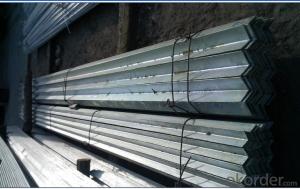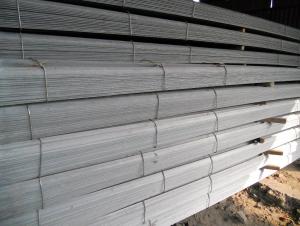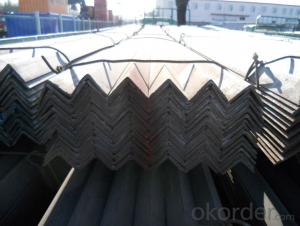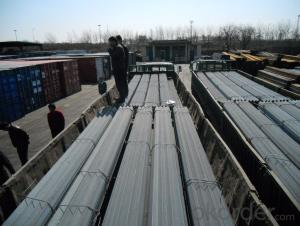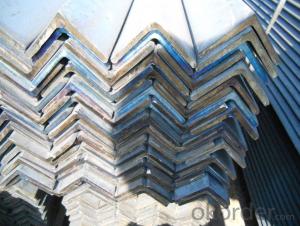GB Equal Structural Angle Steel
- Loading Port:
- Tianjin
- Payment Terms:
- TT OR LC
- Min Order Qty:
- 1000 m.t.
- Supply Capability:
- 30000 m.t./month
OKorder Service Pledge
OKorder Financial Service
You Might Also Like
Product Description:
Specifications of GB Equal Structural Angle
1. Invoicing on theoretical weight or actual weight as customer request
2. Length: 6m, 9m, 12m
3. Material:Material: GB Q235B, Q345B or Equivalent; ASTM A36; EN 10025, S235JR, S355JR; JIS G3192, SS400;
SS540.
4.Sizes:
Sizes: 25mm-250mm | ||
a*t | ||
25*2.5-4.0 | 70*6.0-9.0 | 130*9.0-15 |
30*2.5-6.6 | 75*6.0-9.0 | 140*10-14 |
36*3.0-5.0 | 80*5.0-10 | 150*10-20 |
38*2.3-6.0 | 90*7.0-10 | 160*10-16 |
40*3.0-5.0 | 100*6.0-12 | 175*12-15 |
45*4.0-6.0 | 110*8.0-10 | 180*12-18 |
50*4.0-6.0 | 120*6.0-15 | 200*14-25 |
60*4.0-8.0 | 125*8.0-14 | 250*25 |
5. Material details:
Alloy No | Grade | Element (%) | |||||
C | Mn | S | P | Si | |||
Q235 | B | 0.12—0.20 | 0.3—0.7 | ≤0.045 | ≤0.045 | ≤0.3 | |
Alloy No | Grade | Yielding strength point( Mpa) | |||||
Thickness (mm) | |||||||
≤16 | >16--40 | >40--60 | >60--100 | ||||
≥ | |||||||
Q235 | B | 235 | 225 | 215 | 205 | ||
Alloy No | Grade | Tensile strength (Mpa) | Elongation after fracture (%) | ||||
Thickness (mm) | |||||||
≤16 | >16--40 | >40--60 | >60--100 | ||||
≥ | |||||||
Q235 | B | 375--500 | 26 | 25 | 24 | 23 | |
Usage & Applications of GB Equal Structural Angle
According to the needs of different structures, Angle can compose to different force support component, and also can be the connections between components. It is widely used in various building structures and engineering structures such as roof beams, bridges, transmission towers, hoisting machinery and transport machinery, ships, industrial furnaces, reaction tower, container frame and warehouse etc.
- Q: How do steel angles perform in high-humidity environments?
- Due to their corrosion-resistant properties, steel angles exhibit excellent performance in high-humidity environments. While the air's moisture content often causes metals to rust and corrode, steel angles are specifically engineered to withstand these conditions. Typically manufactured using stainless steel or galvanized steel, both materials possess a protective layer that effectively hinders rust formation. Consequently, steel angles are exceptionally well-suited for utilization in regions with high humidity, such as coastal areas or industrial settings where moisture is abundant. Moreover, their durability and extended lifespan further contribute to their exceptional performance in high-humidity environments.
- Q: Can steel angles be used for transportation infrastructure projects?
- Yes, steel angles can be used for transportation infrastructure projects. Steel angles are commonly used in the construction industry for various applications, including transportation infrastructure projects such as bridges, highways, and railways. They provide structural support and stability to these structures, making them strong and durable. Steel angles are versatile and can be easily fabricated and installed, making them an ideal choice for transportation infrastructure projects where strength and reliability are crucial. Additionally, steel angles have high load-bearing capacity and resistance to environmental factors, ensuring the longevity and safety of the transportation infrastructure. Consequently, steel angles are widely utilized in transportation infrastructure projects worldwide.
- Q: How do steel angles compare to wooden beams?
- Steel angles and wooden beams have different properties and strengths, making them suitable for different applications. Steel angles, being made of steel, are incredibly strong and durable. They have high tensile strength and are resistant to bending and warping under heavy loads. This makes them an excellent choice for structural support in buildings, bridges, and other types of construction projects. Steel angles are also non-combustible, which is an advantage in terms of fire safety. On the other hand, wooden beams offer certain advantages as well. Wood is a natural material that is readily available and renewable, making it a more environmentally friendly option compared to steel. Wooden beams also have a certain aesthetic appeal, especially in traditional or rustic designs. They can be easily customized and shaped, allowing for more creative and intricate designs. However, wooden beams have limitations in terms of strength and durability. They are not as strong as steel angles and can be susceptible to bending, warping, and rotting over time. Wood is also combustible, which can be a safety concern. In summary, steel angles and wooden beams each have their own strengths and weaknesses. Steel angles are ideal for projects requiring high strength and durability, while wooden beams offer a more natural and aesthetic appeal. The choice between the two ultimately depends on the specific requirements of the project, budget considerations, and personal preferences.
- Q: Can steel angles be used as supports for suspended acoustical ceilings?
- Yes, steel angles can be used as supports for suspended acoustical ceilings. Steel angles are often used as a main structural component in suspended ceiling systems. They provide stability and support for the acoustical ceiling tiles and help distribute the weight evenly across the ceiling grid. The steel angles are typically installed at regular intervals along the perimeter of the ceiling and are connected to the main suspension system. This ensures that the acoustical ceiling remains securely in place and can effectively absorb sound and improve the overall acoustics of the space.
- Q: Can steel angles be used for manufacturing staircases?
- Yes, steel angles can be used for manufacturing staircases. Steel angles are commonly used as structural components in staircase construction due to their strength, durability, and versatility. They provide stability and support to the staircase framework and are often used as stringers or supports for the steps. Additionally, steel angles can be easily welded or bolted together to create a sturdy and reliable staircase structure.
- Q: What are the different types of steel angles used in bridge construction?
- Bridge construction commonly utilizes various types of steel angles that serve vital roles in providing structural support and stability to the bridge. 1. Equal Leg Angles, also referred to as L-shaped angles, possess two legs of equal length forming a 90-degree angle. These angles support and reinforce the bridge components during construction. 2. Unequal Leg Angles, as implied, have two legs of different lengths forming a 90-degree angle. These angles are frequently employed in bridge construction to accommodate specific design requirements and support varying loads. 3. Bulb Angles are unique angles characterized by a bulb-shaped leg. They enhance the strength and rigidity of the bridge structure, particularly in areas expected to experience high stress or heavy loads. 4. Inverted Angles are similar to equal leg angles, but their orientation is inverted, with the longer leg positioned at the bottom. These angles provide additional support and stability, especially when the bridge must withstand lateral forces. 5. Fillet Welded Angles are angles joined together using fillet welds. Their purpose in bridge construction is to establish robust and durable connections between different bridge components, ensuring structural integrity and stability. Each steel angle type possesses distinct properties and advantages, rendering them suitable for specific applications in bridge construction. The selection of the appropriate angle type depends on factors such as load requirements, span length, design specifications, and structural considerations. Professional engineers and designers diligently evaluate these factors to determine the most suitable steel angle for a given bridge construction project.
- Q: Can steel angles be used for playground equipment?
- Yes, steel angles can be used for playground equipment. Steel angles are commonly used in the construction of playground equipment due to their strength, durability, and resistance to corrosion. They provide structural support and stability, making them ideal for ensuring the safety and longevity of playground structures.
- Q: What are the different methods of surface preparation for steel angles?
- To ensure proper adhesion of coatings, improve corrosion resistance, and enhance overall durability, there are various methods available for preparing the surface of steel angles. Some commonly used methods include the following: 1. Mechanical Cleaning: Physical tools like wire brushes, sandpaper, or abrasive discs are used to physically eliminate dirt, rust, mill scale, and other contaminants from the steel angle's surface. While this method is simple and cost-effective, it may not be effective for heavy corrosion or stubborn deposits. 2. Chemical Cleaning: Acid-based solutions or pickling pastes are applied to dissolve rust, scale, and other contaminants on the surface. After a specific period of time, the solution is rinsed off. Chemical cleaning is highly effective for removing stubborn deposits but requires careful handling and proper disposal of the chemicals. 3. Power Tool Cleaning: Power tools such as grinders, sanders, or needle guns with abrasive attachments are utilized to remove rust, scale, and contaminants. This method is faster and more efficient than manual mechanical cleaning, making it suitable for large-scale surface preparation. 4. Blast Cleaning: Also known as abrasive blasting, this method involves projecting abrasive materials (e.g., sand, steel grit, or glass beads) onto the steel surface at high velocity using compressed air or centrifugal force. Blast cleaning effectively removes rust, scale, and contaminants, resulting in a clean and profiled surface. While widely used in industrial applications, it requires proper safety measures to protect workers from exposure to abrasive materials. 5. Flame Cleaning: By directing a high-temperature flame onto the steel surface, flame cleaning removes contaminants. The intense heat burns off organic materials and evaporates moisture, leaving a clean surface. This method is particularly effective for removing oil, grease, and paint residues. 6. Conversion Coating: A chemical solution is applied to the steel surface, reacting with the metal to form a thin protective layer. This layer enhances the adhesion of subsequent coatings and provides additional corrosion resistance. Phosphating, chromating, and passivation are common types of conversion coatings. It's important to consider factors such as the extent of corrosion, desired coating system, and environmental conditions when selecting the most suitable surface preparation method for steel angles. Consulting experts or referring to industry standards can assist in determining the appropriate method for a specific application.
- Q: How do you prevent steel angles from vibrating?
- To prevent steel angles from vibrating, there are several approaches that can be taken: 1. Damping materials are effective in absorbing and dissipating vibrations. Rubber pads, neoprene, or foam can be placed between the steel angles and the structure they are attached to. 2. Structural modifications can help reduce vibrations. Additional supports or bracing can be added to reinforce the steel angles, increasing the stiffness and rigidity of the structure. 3. Adding extra mass to the steel angles can stabilize them and minimize vibrations. This can be achieved by attaching weight plates or heavier components. 4. Tensioning the steel angles can reduce vibrations by increasing their natural frequency and stiffness. Bolts can be tightened or tensioning devices can be used. 5. Vibration isolation techniques can effectively minimize vibration transmission. Mounting the steel angles on rubber isolators or spring mounts isolates them from the surrounding structure. 6. Resonance avoidance is crucial in preventing vibrations. By analyzing the structural dynamics and adjusting the design or operating conditions, the natural frequencies of the steel angles can be identified and avoided. 7. Regular maintenance is important to identify any potential sources of vibrations. Checking for loose connections, corrosion, or signs of wear and tear can help prevent vibration problems. It is important to consider various factors such as the application, structural design, and environmental conditions when choosing the best method(s) to prevent steel angles from vibrating. Consulting with a structural engineer or vibration specialist is recommended to ensure the most suitable and effective solution is implemented.
- Q: What are the different types of steel angles used in architectural façade systems?
- Architectural façade systems commonly employ various types of steel angles, each serving distinct purposes and selected based on project requirements. 1) L-Angles: These angles, widely used in façade systems, possess a 90-degree angle and primarily function as the framework for curtain wall systems. Not only do L-angles provide structural support and stability to the façade, but they also allow for the attachment of diverse cladding materials. 2) Z-Angles: Also referred to as Z-bars, Z-angles exhibit a Z-shaped profile, featuring two parallel flanges. They find application in creating horizontal or vertical support members within curtain wall systems, thereby enhancing strength and rigidity. 3) C-Angles: Known as C-channels or C-beams, C-angles gain popularity in façade systems due to their versatility and strength. These angles boast a C-shaped profile with a wide base and two perpendicular flanges. C-angles commonly function as support members for cladding panels or framing elements for architectural features such as canopies or sunshades. 4) T-Angles: T-angles, or T-bars, possess a T-shaped profile and serve diverse purposes in façade systems. They can function as support members for cladding panels, providing a stable attachment base. Additionally, T-angles are utilized in creating mullions or transoms within curtain wall systems, allowing for the integration of windows or glazing units. 5) Unequal Angles: These angles, with unequal leg lengths, find application in façade systems requiring specialized or uneven support. Unequal angles are frequently employed to create custom shapes or profiles, enabling architects and designers to achieve unique aesthetic effects or accommodate specific project requirements. Each type of steel angle offers distinct advantages and applications within architectural façade systems. The choice of angle depends on factors such as structural requirements, design considerations, and the specific needs of the project.
Send your message to us
GB Equal Structural Angle Steel
- Loading Port:
- Tianjin
- Payment Terms:
- TT OR LC
- Min Order Qty:
- 1000 m.t.
- Supply Capability:
- 30000 m.t./month
OKorder Service Pledge
OKorder Financial Service
Similar products
Hot products
Hot Searches
Related keywords












